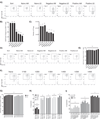Ex-vivo iTreg differentiation revisited: Convenient alternatives to existing strategies
- PMID: 27919837
- PMCID: PMC5274576
- DOI: 10.1016/j.jim.2016.11.013
Ex-vivo iTreg differentiation revisited: Convenient alternatives to existing strategies
Abstract
Ex-vivo differentiation of regulatory T cells (Tregs) from naïve CD4+ T-cells has been widely used in immunological research. Isolation of a highly pure naïve T cell population is the key factor that determines the efficiency of subsequent Treg differentiation. Currently, this step relies mostly on FACS sorting, which is often costly, time consuming, and inconvenient. Alternatively, magnetic separation of T-cells can be performed; yet, available protocols fail to reach sort level purity and consequently result in low Treg differentiation efficiency. Here, we present the results of a comprehensive side-by-side comparison of various magnetic separation strategies and FACS sorting in multiple levels. Additionally, we propose a novel optimized custom made magnetic separation protocol, which not only yields sort level purity and Treg differentiation but also lowers the reagent costs up to 75% compared to the commercially available purification kits. The highly pure naïve CD4+ T-cell population obtained by this versatile method can also be used for differentiation of other T-cell subsets; therefore this protocol may have broad applications in T-cell research.
Keywords: FACS sorting; Foxp3; Magnetic separation; Regulatory T cells; Suppression assay.
Published by Elsevier B.V.
Conflict of interest statement
The authors declare no conflict of interests.
Figures


References
-
- Fantini MC, Dominitzki S, Rizzo A, Neurath MF, Becker C. In vitro generation of CD4+CD25+ regulatory cells from murine naive T cells. Nat. Protoc. 2007;2:1789–1794. - PubMed
Publication types
MeSH terms
Grants and funding
LinkOut - more resources
Full Text Sources
Other Literature Sources
Research Materials

